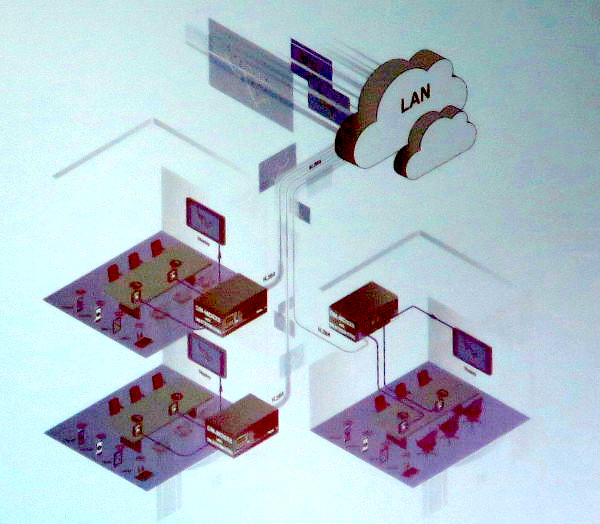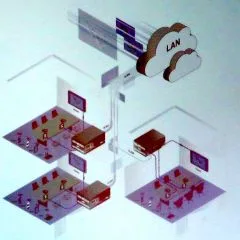At the Sapphire Marketing event in New York last spring, Crestron talked about switching 4k/30 signals and its 4k certification program. At the same event this year, Crestron focused on 4k 60 fps describing products, scalers and certification testing it is doing to try to help installers create trouble-free solutions.
Crestron Executive Director, Chris Perkins, gave a presentation this year at the event starting by introducing new products in the Digital Media (DM) 3.0 series. DM3.0 uses HDMI 2.0 and HDBaseT to switch and distribute 4k/60 video over CAT cable. This enables streaming of the 4k content with the manageability of an IT network. The system is designed to scale from simple 4×1 presentation switching to full 128 x 128 fabrics.
One of the unique features of these switchers is the built-in scaler. According to the company, it was prepared to source a scaler from ‘the usual suspects’, but found that none of them had a 4k 60 fps scaler on their roadmaps. As a result, the company invested millions to develop its own scaler chip and box (DM-RMC-4k-SCALER-C). Creston says it has the only scaler today that can handle 4k/60 in or out. The downscaling is just as important as the upscaling as there will not always be 4k displays available. The scaler chip, which also does frame rate conversions, will also be used on a line of 4k card solutions.
Perkins also addressed the question of HDCP 2.2 content protection. He said this is not important today, but will be more so in a year, especially in the home, where Hollywood content will be played and as the new Blu-ray format and content rolls out. The need for HDCP is determined by the content and must be supported on the source player. As far as Crestron knows, only the Sony FMP X10 4k media player supports HDCP 2.2, however, Crestron products can extend and switch content that has HDCP 2.2 security included. Current HDMI output cards support HDCP 2.2 with input card support coming later this fall.
With 4k content, installers need to pay even more attention to cabling as signal runs will decrease with 4k. The HDMI spec says it can tolerate 1 error in every billion bits, which may sound like a lot, but really isn’t. 4k 4:2:0 content running at 60 fps requires 8.91 Gbps so you can lose around 9 bits every second and still be compliant. Those bit losses are not visible, however.
Bit losses come from interference, bends in the wire, poor connections and interfaces and other sources. The HDBaseT spec is 50m over unshielded CAT5E cable, but Crestron says that this is based on a single cable in a straight line. In real applications, many cables and connections are typical on a run so the company specifies 4 couplers or 5 cables for its certification process. If you use Crestron’s DM 8G cable, you can now run 4k up to 70 m. Its DM Ultra cable can go up to 100m for 4k content (through those four connections).
Restoring signal integrity is also a part of the solution as each piece of hardware includes reclocking circuits to restore good pulse shapes for processing or transmission. These products are getting a firmware update soon to support 4k/60.
Perkins next turned to 4k distribution options. He described “streaming” as using an Ethernet-like infrastructure (Ethernet, HDBaseT, .AVNet) vs. a point to point solution (HDMI, DisplayPort, SDI, etc.). There are clearly benefits and trade-offs to various approaches and Crestron wants to enable customers/installers to make room by room instead of global job decisions about the best solution.
Crestron’s DM stream solution is based on H.264 compression and uses a gigabit Ethernet switch at its core. The company is now building a full product line that includes input and output cards as well as receivers and transmitters. Datarates can be specified at 0.5 to 25 Mbps in unicast or multicast modes. However, it looks like these solutions are aimed at 1080/60 content at this time.
| Crestron: UltraHD Distribution Options | |
|---|---|
| Streaming | Point-to-Point |
| Cheap infrastructure | Zero latency |
| BYOD distribution | No network configuration |
| Limitless distance | Uncompressed video |
| Broad access to rooms | Maximum video quality |
| Source: Crestron | |
We asked if Crestron is considering developing a 10Gps Ethernet solution that can support 4k using HEVC or a light TICO compression, but the answer was “no”.
Streaming is OK if your application can tolerate the latency and compression artifacts, depending on the bit rate. Perkins noted that studies have shown that humans can tolerate up to 50ms of latency for interactive tasks. He then claimed that the best decoders take at least 16 ms or a frame to uncompress a video signal and your display often has a decoder as well that can’t be easily bypassed, which adds more latency, making this a very challenging solution where latency is key.
Crestron’s solution is a hybrid approach where content is distributed from room to room on a compressed network, but uses point to point solutions within the room for a near zero latency result. This can work for 4k content, but only if the LAN is used to download the content or transfer from room to room – not for live streaming. (CC)
Analyst Comment
Crestron used the phrase 4k in its talk, but did not clarify if it really meant 4k/DCI or UltraHD. We suspect it’s really UltraHD, but we hadn’t got a response on a request for clarification at press time. (BR)


